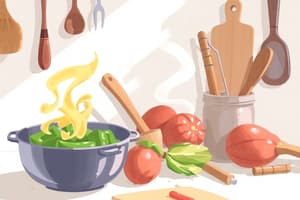Podcast
Questions and Answers
Cimeter knives are a type of chef knife.
Cimeter knives are a type of chef knife.
False (B)
Breaking knives are used for delicate knifework.
Breaking knives are used for delicate knifework.
False (B)
Boning knives can have either a narrow or wide blade that comes in flexible, semi-flexible, or stiff options.
Boning knives can have either a narrow or wide blade that comes in flexible, semi-flexible, or stiff options.
True (A)
Fish knives were invented in the medieval era.
Fish knives were invented in the medieval era.
Dinner knives are the standard knife to use for breakfast and lunch only.
Dinner knives are the standard knife to use for breakfast and lunch only.
Flashcards are hidden until you start studying
Study Notes
Kitchen Knives
- A knife is a vital tool in a chef's kit, used for various food prep tasks.
- Parts of a modern knife:
- Blade
- Handle
- Point (end of the knife for piercing)
- Edge (cutting surface extending from point to heel)
- Grind (cross-section shape of the blade)
- Spine (thickest section of the blade)
- Fuller (optional groove to make the blade lighter)
- Ricasso (optional flat section at the junction of blade and bolster or guard)
- Guard (optional barrier between blade and handle to prevent hand slipping)
- Hilt or butt (end of the handle for blunt force)
- Lanyard (optional strap to secure the knife to the wrist)
Types of Kitchen Knives
- Chef Knife (most versatile, a must-have in every kitchen)
- Utility Knife (mix between chef knife and paring knife)
- Cleaver (for breaking down meat, bones, and dense foods)
- Paring Knife (lightweight, short blade with a pointed tip for delicate work)
- Butcher Knife (long, curved blade with a sharp point for cutting through meat)
- Bread Knife (long, straight blade with a serrated edge for sawing soft items)
- Boning Knife (narrow or wide blade, flexible, semi-flexible, or stiff options for cutting meat)
- Oyster Knife (essential for shucking oysters)
- Carving Knife (long, narrow blade that tapers to a sharp point for slicing)
- Cheese Knife (small, for slicing and portioning cheese)
- Santoku Knife (Japanese-style, wide, straight blade with a curved spine)
- Nakiri Knife (Japanese-style, thin, lightweight, rectangular blade with a straight edge)
- Tourne Knife (short, curved blade, mimicking a bird's beak)
- Breaking Knife (type of butcher knife for cutting large sections of meat)
- Cimeter Knife (type of butcher knife, similar to breaking knife)
Table Knives
- Butter Knife (short, broad shape, dull, rounded edge for spreading butter)
- Steak Knife (similar blade length to dinner knife, serrated edge, and pointed tip)
- Fish Knife (invented in the Victorian era, specialized for soup course, fish course, and meat course)
- Dinner Knife (standard knife for breakfast, lunch, and dinner)
- Dessert Knife (smaller than dinner knife, for dessert courses)
Philippine Knives
- Balisong (also known as Butterfly Knife, Fan Knife, or Batangas Knife)
Studying That Suits You
Use AI to generate personalized quizzes and flashcards to suit your learning preferences.




